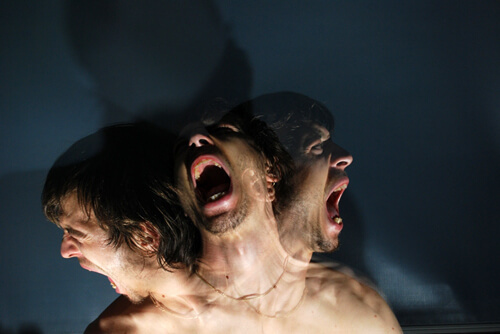Severopathy
 Senestopathy is a kind of perception disorder with special properties and manifestations, which differ greatly from the perception of simple healthy persons. Senestopathy pushes the person herself into thoughts about the presence of her impartial and even fatal pathologies. Severopathy can be considered, according to many sources, a kind of hallucination, namely visceral hallucinations. As a rule, sensory delirium is formed on the basis of these twisted pathological sensations, which is capable of acquiring different composition. A person with such serious impairment of perception can come into psychomotor arousal and requires special conditions for the content and curtailing of these manifestations.
Senestopathy is a kind of perception disorder with special properties and manifestations, which differ greatly from the perception of simple healthy persons. Senestopathy pushes the person herself into thoughts about the presence of her impartial and even fatal pathologies. Severopathy can be considered, according to many sources, a kind of hallucination, namely visceral hallucinations. As a rule, sensory delirium is formed on the basis of these twisted pathological sensations, which is capable of acquiring different composition. A person with such serious impairment of perception can come into psychomotor arousal and requires special conditions for the content and curtailing of these manifestations.
Severopathy - what is it?
Senestopathies belong to the topic of perceptual disorders. The concept of senestropathy is of French origin, but on the whole it has many synonyms in its composition. From the Greek, for example, it is translated as a general pathological sensation, which well reflects the entire pathology of the situation of a person who is confronted with senoropathies.
Severopathy manifests as pathological sensations that arise in different parts of the body or internal organs in the form of an unpleasant painful painful feeling of tingling, pressure, burning, twisting, contraction, which is not associated with any somatology.
Diagnostic criteria of severopathy play an irreplaceable role in differential diagnosis. It is especially important to differentiate this pathology with paresthesia, which can exist within normal limits. It is also important not to confuse this pathology with somatic, because initially the patient turns to the therapist.
Diagnostic criteria of senestopathies have special characteristics: polymorphism, that is, a variety of feelings, which does not allow attributing complaints to a particular organ. Complaints are very far-fetched and unusual, this feeling can not arise at any somatics. An unpleasant, affectively colored tone of feelings, which brings massive discomfort and sometimes pushes a person with severopathy to extreme measures. The person is not able to formulate them because of the pretentiousness of complaints, while they are always negative and much worse than the usual classical pain. The localization of sensations is not inherent in somatics, it migrates, changes and is not limited by the time of appearance and anything else. Also, there is no limit to the soreness of the analyzer, that is, the sensations are so atypical that there is a need to clearly ask patients about these feelings. After all, their complaints are not just pain in a particular organ, it's a whole set of unusually depressing sensations.
For the first time this symptom was described by the famous psychiatrist Dupree, who also studied catatonia and even the founder of the hood symptom, the so-called hood of Dupree. Dupree studied psychiatry in France, and then Camus also joined his studies, together they issued a whole book devoted to the parasites.
Many researchers have taken up this issue because of the non-specificity of the senestopathies and their occurrence in virtually any endogenous and even many exogenous pathologies.
In our time it is believed that senestopathies are formed due to disruption of interoceptive regulation of impulses, so subthreshold stimuli give such persons impartial painful sensations. For senostopathies, also characteristic features of the structure of the GM, as well as the characteristics of the individual, such as pubertal or high level of suspiciousness. From the point of view of psychotherapy, it is even believed that the brain consciously perceives subthreshold stimuli as masochism and need for pain. This theory is provocative enough, but as a separate argument in hysteroid persons has the right to exist. There is no explicit anatomical zone for canelopathy, but there are many studies on the significance of the frontal cortex in the perception of pain, because if a person is held lobotomy, then she no longer complains of pain. A sense of euphoria removes any pain, but at the cost of dementia and complete disintegration of the individual.
Causes of hay fever
Senestopathy has many underlying causes related to different branches of pathology. Sinestopathies do not carry a real cause, causing this pathology. Sensations are always mental and have only a psychic underlying reason. Most often, it is part of the individual diagnoses, can enter into many pathologies.
Senestopathy occurs when an aneuroidal obscuration of consciousness occurs. Neuroses and neurosis-like conditions also have obsessive and tormenting sensopathies. Although this is a neurotic level, but cannibalism brings considerable discomfort to the person, filling all her thoughts.
Severopathy is characteristic of the depressive phase of bipolar-affective disorder, recurrent depressive disorder and any other depressive conditions. Such depressive states are classified as depression with psychotic disorders. The psycho-organic syndrome also has in its composition senestopathy, often aggravating the prognosis of the course of pathology. All traumatic psychoses have such compositions, and often such soreness can be included in the structure of intoxication pathologies, alcoholism, drug use, intoxication after trauma, toxic poisons, poison and drugs.
Schizophrenia is most typical for the appearance of hayfever, this leads to the development of interpretive delusions. The most characteristic is the structure of the Kandinsky-Clerambo syndrome.
Hysteria also often has hay fever, because it has many manifestations, hysteria is very multifaceted. Hypochondria also has in its composition senestopathy, it is often included in the structure of depression. A lot of psychoses are accompanied by perceptual disorders, as this has a multiplicity of appearances. Astheno - neurotic syndrome has a different prognosis, depends on the course, but cannostropathy often aggravates such a course of this syndrome. Neurasthenia is characteristic of hysteroid persons and as a mild manifestation of neurosis.
Effective-delusional states also often lead to such consequences. Severopathy with neurosis as a whole is characterized as a fairly common problem.
Climax and its accompanying vegetative syndromes also have similar problems in their composition, they are often complicated by shestopathies. And all these involutionary processes often take place with considerable complexity and are accompanied by impaired sensations throughout the body. Most such symptoms are associated with the prevailing vegetative.
A lot of theories try to explain all hallucinatory experiences, including senestopathy, which is connected with their metamorphosis and the heterogeneity of their origin. In such a pathology, one pathogenesis can not be deduced, which is associated with the expressive problems that lead to the appearance of such disorders. Pavlov's followers associate senestopathies with the disorders of GNI, which is generally correct, but very generalized. Senestropathy is characterized by dissociation of cortical and subcortical structures, which leads to disruption of the mediators and the synthesis of excessive amounts of dopamine with the provocation of non-existent feelings. Domestic colleagues believe that hypochondriacal senestropathies arise in hypnoid dumbness of consciousness, and if they are present during wakefulness, then the cause is fear and anxiety, which often accompany almost all psychiatry. In some monographs it is believed that the pathologies accompanied by senestopathies, like schizophrenia, violate the correct de-differentiation of brain structures, which subsequently leads to dissociation, releasing the "dark" side of the person out.
Symptoms and signs of severopathy
Severopathy is an extremely painful sensation in the internal organs or in parts of the body. Many patients note that it would be better to "just hurt" than this feeling. When you ask a patient with hairspot feelings, you do not need to say yourself: "Do you feel pain?", It is better to ask to describe these feelings. After all, only so you can find all their pretentiousness, often absurdity and inconsistency to the relevant body. Objective causes of hay fever, that is, not mental, but somatic to find it will not be possible. You do not need to immediately write all the complaints of mentally ill people on senestopathy, you need to first examine them, excluding any somatic, and only after that apply antipsychotics.
It is important to remember that most often with time, any senestopathies, that is, visceral hallucinations are overgrown with interpretive delusions, so if a person talks about unpleasant sensations, but does not show his delusional suspicions, it is important to consider their presence. Persons with interpretive delusions are very dangerous, their delirium varies depending on the changes in hay fever. Under its influence they can even bring harm, and it is formed because of the need of the brain to explain to itself all these pathological sensations.
Senestopathy, due to its polymorphism, always begins as simple sensations of pressure, severity, and burning. But over time, hay canopy develops with new characteristics, changing a lot. They constantly migrate with unpredictable localizations and with a change in the projection of sensations. They are becoming more and more intricate, combined with each other, affecting completely unpredictable organs.
Generally celestial passions are projected onto the inner self, into the area of inner sensations. Some patients even say: "I see it with my inner eye," "I feel it inside myself."
Depends on the provoking shestopathy pathology, they vary. When depressed, patients characterize senestopathic complaints as something alive: "I feel parasites inside my head," "I'm in suspense, why I'm bursting," "everything inside me froze."If complaints reach a megalomaniac nature: "everything inside me is rotten, and the whole world is rotting and collapsing, we are waiting for the apocalypse", then this pathology can be attributed to the syndrome of Kotar. This is a manifestation of severe depression with senestopathy, hypochondria and psychotic symptoms. Senestopathies do not show themselves isolated, except in cases of chronic hallucinosis. Usually there is always a psychiatric symptomatology that accompanies the main problem.
The localization of the senestopathy is very diverse, but it is often limited to the head, neck or limbs. Person can not be persuaded in the absence of these sensations. Many patients say that they have snakes in their intestines. And even if you make an incision and sew it up, show some sick snake to the patient in the bank, he will not calm down. After a while he will again say that he has parasites or snakes. When objections that it was deleted, he may notice: "Adult you have deleted, but the cubs have remained."
Severopathy with neurosis accompanied by panic attacks and pronounced vegetative. The person at the neurotic level realizes all the abnormality of his experiences and is very anxious to get rid of them, but has no future. It is important to support such individuals, because this is not insanity, but dissociation in the work of the cerebral cortex.
Examples and types of severopathy
Haystacks have many subspecies, they are divided by their content.
• Thermal cenopathy has such subspecies: sensations of heat, the type of scorching sun and burning, the type of exposure to physical rays or radiation, cold, the type of frostbite or frostbite. Sometimes patients say they can not find an opportunity to warm up.
• Severopathy kinesthetic composition, the type of sensation of movement and movement. These feelings cause a sense of movement, twisting. Patients complain that they feel how the skin separates from the body, how the bones are twisted, the sensations in the form of the movement of fluid in the body. They feel blood transfusion in the vessels, peristalsis of the organs, clogging of the organs or muscles, pulsation in the vessels and in the heart. Sometimes there is a sensation of blockage, and they say that they can not eat because their stomach is clogged.
• Severopathy in the form of particularly severe pain, drilling. The people say that they feel drilling in the head, woodpecker chiselling and other unbearable feelings. Feelings of tension, they say that all their muscles are stretched to the limit, that they can not withstand this tension, they can not relax any part of the body.
Haystacks have their own kinds, which depend on many factors:
• Elementary cenopathies are projections of internal sensations, they do not have a clear location. The person simply feels the tension inside, incredible pressure and numbness. They are directly related to feelings of emotion. The more intense the affects of anxiety, fear, the more pronounced are the senility. Often, such painful sensations of the tension of the organs are also accompanied by feelings of longing and tension. This is typical for depression, and not only with affective disorders, but also with feelings of disturbance of his body, down to depersonalization.
• Simple senestopatii characterized as simple feelings, but they are not just a feeling, and pronounced affective colored feelings. This sensation of pain, in individual senses, is the thermal sensations, cooling and heat, paresthesia with unknown localization. Often they diverge and spread out through the body, becoming diffuse. Sometimes the opposite is restricted in one zone or even an organ. Sepstopathies in this subspecies are of several types, they are algic, that is, according to the type of pain. But they are with a huge set of shades, not like typical pains. For example, burning with a sharp feeling of baking, a feeling of squeezing, shooting sensations, eversion, cutting. Dull pains with unusual localization also belong to the senoropathy. The pains of individuals are always fickle, they change and move.
• If a person is concerned about paresthesia by the type of severopathy, the patient complains of itching. Sometimes numbness, tingling, but it may be neurological manifestations. A separate subspecies of severopathy is present in the form of a change in weight, according to the type of sensation of lightness or the opposite gravity. They note that the head is very heavy or they can not walk because one leg is heavier than the other. And sometimes, on the contrary, they can not do anything because of the ease in their hands.
• Psychosensory senestopathies manifest themselves in geometric changes in body parts, viscera and the body itself. The brain protrudes from the skull, the stomach is twisted, the joints turn out to be "on the edge".Sometimes a person's body pattern changes and there are feelings that the organs are not in the right places.
• Interprititve senostopathies are formed when a person tries to explain their feelings. Then they begin to ascribe to themselves all kinds of deadly diseases from which it is impossible to be cured.
• Hallucinatory shestopathies are formed by the type of hallucinations. There may be a geometric type, a certain geometric figure on the abdomen hurts. Sometimes it happens by the type of grabbing haptic hallucinations. Sometimes they are accompanied by hallucinations from other sensory organs.
Treatment senestopatii
senestopatii as a kind of hallucinations are treated by the classical scheme, but it is important to warn the patient and his relatives about the long-term treatment is not always successful outcome. In general, cupping has strong variations, depending on the pathology that caused sheentropathy at the base. In schizophrenia, hallucinations, and other like use of neuroleptic drugs with antipsychotic pervoosnovnoe docked and sedative effect, in the separated cases it is possible to select and stimulate. Such aids include: Chlorpromazine, klopiksol akufaz, Tisercinum, Truksal, haloperidol, Triftazin, Mezheptil, Azaleptol, Rispiridon, Kveteron, Kveteapin, Solean, Sardinol, Serdolekt, Fluanksol, Sonapaks, Eglon frenolona. In general, all psychotic disorders are removed with the help of neuroleptics.
In the future, the use of prolongations is possible: Palipiridol, Arap, Imap.
It is important to take into account the side effects and apply the drugs to remove them: Cordiamin, Camphor, Galantamine, Amantadine, Proserin, Parlodel, Bromocriptine, beta blockers, Anaprilin, Tsiolodol, Dimedrol, Calcium gluconate, Magnesia, Sibazon.
Antidepressants are used for senostopathies due to depressive manifestations: amitriptyline, cyrramyl, sertraline, SSRIs, valproates, lithium salts, lithosan, lithium carbonate and oxybutyrate, carbamazepine, quetiapine.
In these states, the criticism of the patient is not available, that does not give a chance and techniques in acute conditions apply psychotherapy at senestopatii important to remove these painful conditions. In some cases, antidepressants are also effective. Senostopatii are characterized by persistence, so do not give up, it is important to try to change medications to the correct selection of the drug.



